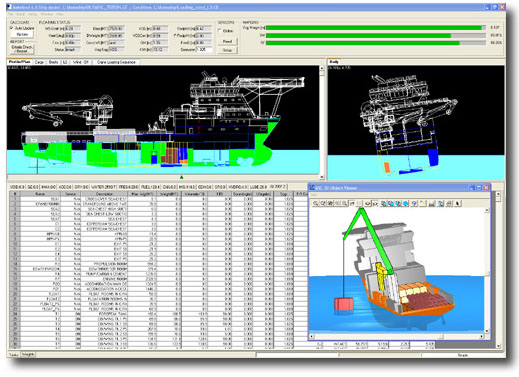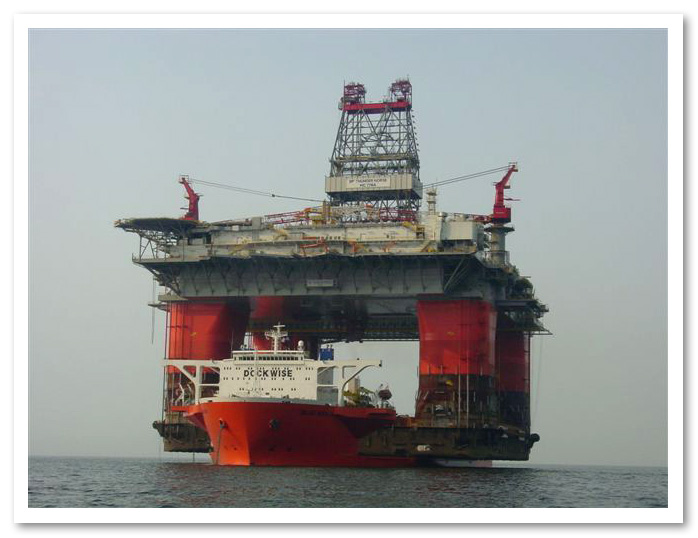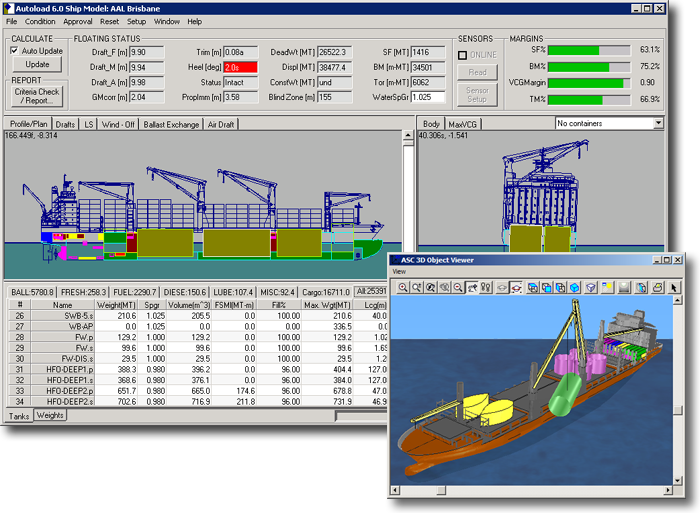Stability Software
Autoload Overview
Autoload is the most advanced universal loading computer software designed to estimate and control parameters of stability, strength and floating status of virtually any type of ships - bulk, break bulk, tanker, ro-ro, container, heavy lift, naval, cruise, fishing, survey, supply vessel... and more!
 Single- or multi-hull, semi-submersible - all types of free floating vessels and offshore installations can be processed by Autoload.
Single- or multi-hull, semi-submersible - all types of free floating vessels and offshore installations can be processed by Autoload.
Unlike many other loading computers on the market, Autoload does not rely on pre-calculated hydrostatic data from the ship’s Loading Manual. Instead it uses the true 3-dimensional model of the ship’s hull and internal compartments in combination with the hull form based calculation methods to obtain ship’s floating status and hydrostatic parameters. The same methods are used to produce approved stability booklets.
The adopted calculation methods allow Autoload to provide very accurate results not only when the ship is in normal operational condition, but in a damaged condition and/or a condition with abnormally great heel or trim when the accurate and reliable results are needed the most.
SPS modules connected to Autoload compliment it with additional graphical cargo planning functionality specific to different types of cargo and crane operations. 
Autoload has type approval from all major Classes and has been installed on more than 1000 vessels. Among them are very unique and complex vessels such as semi-submersible heavy lift ships. M/v “Blue Marlin” and the oil rig “Thunder Horse” shown on the picture used to be the biggest semi-submersibles at the time. Both of them were equipped with Autoload integrated in to their control systems.
Highlights of Autoload
Graphical User Interface
Autoload features intuitive and easy to understand graphical user interface. All the major controlled parameters are permanently displayed on the screen in numerical format and in the form of diagrams.

Interactive graphical plan, profile, body and 3D views show level of fluids in tanks and ship’s position in the water.
The user can manipulate contents and status of tanks directly in the graphical views or in the Tanks table.
MaxVCG, longitudinal strength diagrams, drafts survey, ballasting sequence, auto-ballasting functions, etc. are readily accessible from the main screen through a selection of tabs.
The Autoload’s graphical interface is a result of more then 20 years of experience and design of windows applications, always utilizing the latest available programming tools and technologies.
Hydrostatic Parameters

In real time Autoload calculates and updates values of over 40 hydrostatic parameters. The program can be configured to permanently display the most important ones in the pre-defined place on the screen. All other parameters can be monitored in a special Hydrostatic Values window and in the reports.
Parameters of tanks, such as positions of Centre of Gravity and Free Surface moments, are dynamically updated based on the tanks 3D geometry, shift of content in slack tanks and actual position and shape of free surface at the current floating position of the ship.
Controlled parameters of ship’s stability, strength and floating status are monitored against the limits. Clear visual alarms are issued when a value is not within the allowable range.
Damage Stability
Autoload is a Type 3 stability software according to the IACS UR L5 classification. In addition to checking intact and damage stability on basis of a KG/GM limit curve(s) Autoload allows the user to simulate any damage condition directly applying damage cases for actual loading condition.
Direct damage stability assessment functionality is an integral part of Autoload, it does not require any additional separate programming module(s).
Tank and Draft Sensors
Autoload can be connected to various types of tank and draft sensors. That allows monitoring actual ship’s loading condition and floating status in real time from the comfort of deck office. With one click the user can switch Autoload between the on-line and simulation modes.
Reporting

Autoload generates an array of print-ready reports in an electronic format. That includes stability, longitudinal strength, loading summary, and other common reports. New custom reports can be added and the format of the reports can be modified with the aid of the macro commands.
Reports can be archived in a common searchable electronic format, or sent directly to a printer.
Customization
Autoload is very versatile and flexible program that features extensive and ever expanding set of macro commands.
Controlled hydrostatic parameters, stability criteria, elements of interface, format of the reports - all can be configured to the practical needs and the requirements of Class to the specific ship.
Contact us for more information and to schedule a live demonstration of Autoload.
